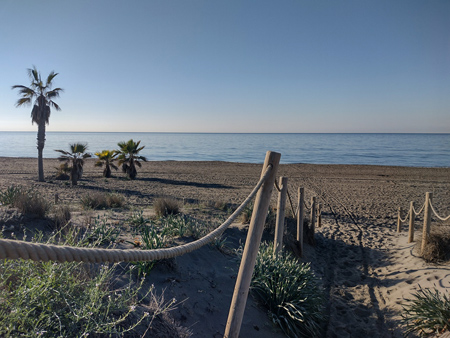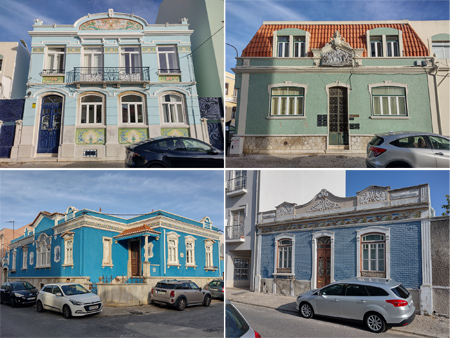
Over New Year’s I tweeted “If you haven’t been to Setúbal, then get here asap” & I meant it! For some reason, the city had been off my radar but what a beautiful discovery. Here’s a bit of why we fell in love with Setúbal… & not just for choco frito 😉
After visiting Rafa’s family outside of Málaga for Christmas, he wanted to ring in the new year in Portugal. We hadn’t been to our favorite destination together for some time, so I was all for it. But instead of Lisboa, I wanted to explore a new spot not far from the capital; Setúbal seemed like the perfect getaway.
I booked our hotel a few months in advance, & by some stroke of luck we got the corner room on the top floor (not the curved room below, but the room at the other end). Those expansive, balcony views turned out to be perfect for sunsets & to watch fantastic fireworks on the 31st… plus they gave us a bottle of espumante as part of a festive NYE kit. Many thanks to Hotel Meliá for a wonderful stay!

Regardless of constantly changing weather, we saw as much as we could during our brief stay. To be honest, Setúbal surprised me in many ways. First of all, the Christmas decorations were fantastic. The business core of the old town was decked to the nines & had such a fun, holiday vibe… from the town hall to local merchants to people just hanging out, I felt more holiday spirit than I had in a long time:
Given its location, one of the main attractions of Setúbal is anything along the waterfront. Whether taking the ferry to Tróia —we’ll have to do that next time— or watching the boats or exploring the dock or strolling along the beach or admiring sweeping views from the Forte de São Felipe, an estuary of the Sado River makes a perfect passageway for both ships & for fish… as the mid-20th century map in the town hall makes perfectly clear:
And speaking of fish… the Setúbal market takes the award for most vibrant & bustling that I’ve ever seen. Of course lots of locals were hanging out with friends in the bars, saying goodbye to 2023. Likewise, people bought every kind of seafood imaginable for an end-of-year feast. The endless variety made us wish we had a kitchen to cook in as well!
At least I could try local oysters while pondering beautiful tile work: one giant panel from 1930 signed by Pedro Pinto + entrance panels from 1944 by Rosa Rodrigues. See that giant swordfish? I talked with the fishmonger the next day & he said he’d sold the whole thing. Not the mention the huge variety of bread, fresh produce, meats & even presunto. So wonderful.
With such a strong connection to the sea & to seafood, one of the biggest industries to develop in Setúbal was canning sardines. High quality & high demand fueled this labor-intensive product, & an entire factory has been turned into a museum. The Museo do Trabalho formed under the guidance of French ethnologist Michel Giacometti, has won distinguished awards & pays a beautiful homage to the workers of the former Perienes factory.
As a major museum junkie, this place really blew me away. Video & audio interviews with former workers really make you feel the hard labor that went into producing every can of tinned sardines. In addition, there are displays of lithographs used for making labels as well as interesting bits about making cloth & other aspects of daily life in Portugal. Absolutely fantastic visit.
We returned to the city center often, & from first sight it reminded me of a more vibrant version of the Baixa in Coimbra. Lovely bars & cafés nestle between houseware shops & old bookstores:
The area near our hotel must have been a development for wealthy families around the turn of the 20th century. Beautiful homes covered with tiles still sit scattered among modern housing. And there were so many wonderful tiles to look at around the city, even a surprise figura de convite. I’m obsessed with the blue & yellow modern tiles by Carlos Calvet on the Social Security office near the port. I need those for my living room!!
There’s quite a lot of religious architecture to appreciate in Setúbal, notably some beautiful Manueline doors incorporated into newer Baroque churches… my favorite was one we happened upon while walking from the bus/train terminal, part of the female Dominican convent of São João Baptista & designed with clusters of grapes (below, right):
Other gorgeous treats were the Igreja de São Sebastião, the Casa do Corpo Santo (an extinct brotherhood formed by sailors & fishermen), preserved painting inside the former Banco de Portugal building, a mini-Mosteiro dos Jerónimos built first (unfortunately not open during our stay due to holiday closures) & the wonderful Sé interior. We also popped in the breathtaking Capela de Bonfim but didn’t take photos during Mass.
So yes, we ate too… and very well! Deep-fried cuttlefish (choco frito) is the local specialty, & we tried some at the Adega do Zê. I’ll be honest: I prefer the Spanish style, but my espetada de lulas was fantastic. As were all the side dishes. Amazing staff too! Definitely my kind of place. We also had a lot of other fish, some alheira, & some self-catered meals with items from the Pingo Doce.
Rafa & I managed to see a good bit of Setúbal, especially with crazy weather & year-end schedules. There’s more to explore, but we loved the area during the four days we stayed. I’m looking forward to returning in order to eat more —as always— & to check out more of the natural park area on the peninsula. If anyone has tips or suggestions, we’d love to hear them. Até já, Setúbal!












